chinese_cuisine
- 格式:ppt
- 大小:8.78 MB
- 文档页数:59

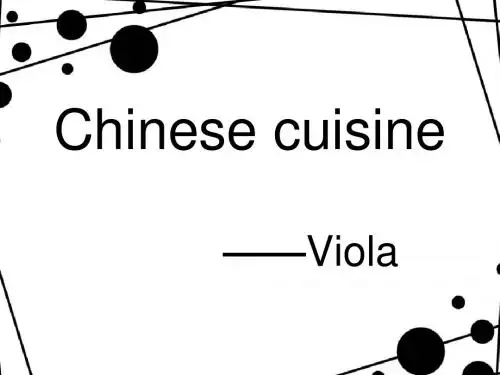
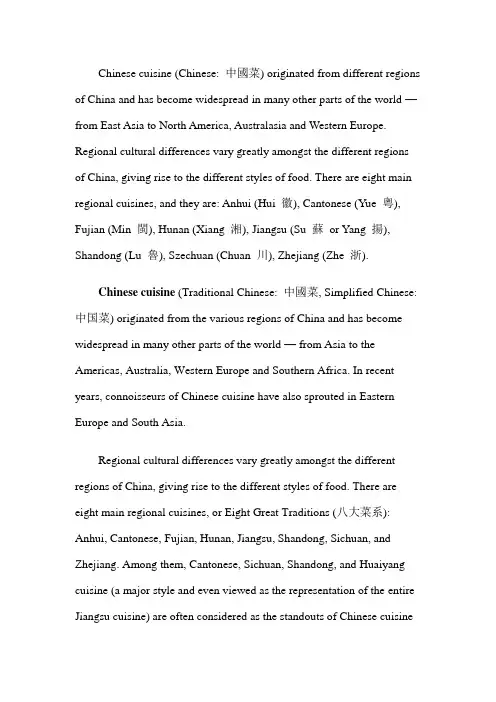
Chinese cuisine (Chinese: 中國菜) originated from different regions of China and has become widespread in many other parts of the world —from East Asia to North America, Australasia and Western Europe. Regional cultural differences vary greatly amongst the different regions of China, giving rise to the different styles of food. There are eight main regional cuisines, and they are: Anhui (Hui 徽), Cantonese (Yue 粵), Fujian (Min 閩), Hunan (Xiang 湘), Jiangsu (Su 蘇or Yang 揚), Shandong (Lu 魯), Szechuan (Chuan 川), Zhejiang (Zhe 浙).Chinese cuisine (Traditional Chinese: 中國菜, Simplified Chinese: 中国菜) originated from the various regions of China and has become widespread in many other parts of the world — from Asia to the Americas, Australia, Western Europe and Southern Africa. In recent years, connoisseurs of Chinese cuisine have also sprouted in Eastern Europe and South Asia.Regional cultural differences vary greatly amongst the different regions of China, giving rise to the different styles of food. There are eight main regional cuisines, or Eight Great Traditions (八大菜系): Anhui, Cantonese, Fujian, Hunan, Jiangsu, Shandong, Sichuan, and Zhejiang. Among them, Cantonese, Sichuan, Shandong, and Huaiyang cuisine (a major style and even viewed as the representation of the entire Jiangsu cuisine) are often considered as the standouts of Chinese cuisineand due to their influence are proclaimed as the Four Great Traditions (四大菜系). Occasionally, Beijing cuisine and Shanghai cuisine are also cited along with the aforementioned eight regional styles as the Ten Great Traditions (十大菜系). There are also featured Buddhist and Muslim sub-cuisines within the greater Chinese cuisine, with an emphasis on vegetarian and halal-based diets respectively.Chinese CuisineThe vastness of China's geography and history echoes through the polyphony of Chinese cuisine. To begin, it is best to divide Chinese cuisine, with all the appropriate disclaimers and caveats, into that of four major regions: the northern plains, including Beijing; the fertile east, watered by the Yangtse River; the south, famous for the Cantonese cooking of the Guangdong Province; and the fecund west of Szechwan and Hunan Provinces.Canton is, perhaps, the most famous of the food areas. Long, warm, wet days throughout the year create the perfect environment for cultivating most everything. The coast provides ample seafood, the groves are filled with fruits. Cooking methods and recipes here are sophisticated and varied. Since the local produce is so gorgeous, the cooking highlights its freshness, relying less on loud sauces anddeep-frying.To the mountainous west, in Szechwan and Hunan provinces, steamy heat and spicy foods fill the restaurants. Rice grows abundantly, as do citrus fruits, bamboo, and mushrooms. The spiciness of the food tells of locally grown chiles and the inclinations of the local palate, though some say the spices are used to mask the taste of foods that rot quickly in the heat.To the east of Hunan lies "the land of fish and rice." Like the west in latitude, it has the added bonus of lowlands for rice cultivation and a rich ocean's edge for fish.The northern region of China reaches into the hostile climate of Mongolia -- land of the Gobi Desert and Arctic winter winds. Mongolian influence appears in the prevalence of mutton and lamb -- many in the region are Muslim, so pork is forbidden -- and in the nomadic simplicity of the Mongolian fire pot. The north is not amenable to rice cultivation so, wheat, barley, millet and soybeans are the staples; breads and noodles anchor the meal. The vegetables and fruits -- cabbage, squash, pears, grapes, and apples -- are like those grown in North America. Beijing is the pearl of the region; royal haute cuisine was born and bred inside her walls. However, the centuries and the accumulated wisdom of China's best chefs have conspired to make imperial cuisine an incredible achievement that belongs to all of China.Once the meal is cooked, it is served all at once to the family, who eat with chopsticks and drink soup with a wide spoon. The average dinner includes a starch -- rice, noodles, bread, or pancakes -- a meat dish, vegetable, and soup, which serves as a beverage. For formal meals and banquets, there are many successive courses which are served in a strict traditional order.Guangdong CuisineWhen people mentioned Guangdong Cuisine, they can always associate it with the traditional dishes such as sweet and sour Gulao meat, Gravy pork with preserved potherb mustard, Roast Piglet with Crisp Skin. Guangdong cuisine has been heavily influenced by western cooking cultures, which is unique among the Chinese cuisines. Its raw materials, cooking methods, and flavorings all differ from the other cuisines.Guangdong cuisine has absorbed the cooking skills of the West as well as that of other Chinese regions, to develop its own unique methods. Guangdong chefs also pay much attention to the artistic presentation of their dishes. So Guangdong cuisine became more and more popular nowadays.Our experts will explain the training courses step by step from configuration of the kitchen to various kinds of cooking skills. Seafood process, bench work, dish garnishing, stove operation, all delails are introduced exactly in conformity with Guangdong Cuisine kitchen. Skillsof cooking material preparation, food decaration, Sauce and jam making, steaming work, base-soup and other local snack making, are also park of our training courses. Our master chefs will show you the original methods of cooking pork, poultry, freshwater food, seafood and seasonal vegetables. At the same time, we can also teach you how to manage the kitchen well .You will receive the common menu as a present Guangdong Cuisine(Cantonese Cuisine)Cantonese food originates from Guangdong, the southernmost province in China. The majority of overseas Chinese people are from Guangdong (Canton) so Cantonese is perhaps the most widely available Chinese regional cuisine outside of China.Cantonese are known to have an adventurous palate, able to eat many different kinds of meats and vegetables. In fact, people in Northern China often say that Cantonese people will eat anything that flies except airplanes, anything that moves on the ground except trains, and anything that moves in the water except boats. This statement is far from the truth, but Cantonese food is easily one of the most diverse and richest cuisines in China. Many vegetables originate from other parts of the world. It doesn't use much spice, bringing out the natural flavor of the vegetables and meats.Tasting clear, light, crisp and fresh, Guangdong cuisine, familiar to Westerners, usually chooses raptors and beasts to produce originativedishes. Its basic cooking techniques include roasting, stir-frying, sauteing, deep-frying, braising, stewing and steaming. Among them steaming and stir-frying are more commonly applied to preserve the natural flavor. Guangdong chefs also pay much attention to the artistic presentation of dishes.The Characteristics of Chinese Cuisine NamingFood varies from place to place, and from nation to nation. Therefore, there is a regional difference in cuisine naming. This essay is confined to the naming of the Chinese cuisine found in Beijing is the capital of the People’s Republic of China, it harbors people from every corner of the country, and restaurants with every cooking style and cuisine system in China. The naming of Chinese cuisine has its primary motivations and secondary motivation.The Four Categories of Chinese CuisineChinese cuisine can be geographically divided into four categories: Guangdong cuisine, Shandong cuisine, Jiangsu cuisine and Sichuan cuisine according to the book of Chinese Cuisine Culture.Guangdong cuisine consists mainly of Guangzhou cuisine, Chaozhou cuisine and Dongjiang cuisine along the Pearl River. As a representative of Lingnan cooking culture, Guangdong cuisine is one of the major families of Chinese cuisine. Therefore, "eating in Guangzhou" has become widely well known. Guangdong cuisine is a typicalcombination of ingredients and techniques from Japan, Southeast Asia, Middle East and Europe, etc.Shandong cuisine is divided into Jinan, Jiaodong and Confucian Mansion different three styles and flavors around the Yellow River. Of which, Confucian Mansion is cooked with great care by the mansion's master cooks in keeping with the instruction of Confucius. As a result, the dishes are both characteristic of a learnt and sagacious family and typical of a lordly mansion.Jiangsu cuisine, along the lower reaches of the Yangtze River, consists of the styles of Huaiyin-yangzhou, Suzhou-Wuxi, Nanjing and Xuzhou-Taizhou, of which, Yangzhou is a famous cultural city with a history of nearly two thousand five hundred years and has been a place of men of letters since ancient times. The eating habits of men of letters influenced and enriched Jiangsu cuisine culture.Sichuan cuisine is produced on the upper reaches of the Yangtze River and has a great impact on the culinary culture in southwest China.Chinese Cuisine PK Western FoodChinese diet is quite different from Western diet. While Western diet focus only on weight loss,Chinese diet includes foods which treat and bring the body into balance, thus improving functions of organs and health to achieve weight loss. Another difference between these diets isthat in western diet foods are considered for their protein, calorie, carbohydrate, vitamin and other nutrient content but in Chinese diet, foods are considered according to their energy, flavours and their actions on organs of the body.The flavour of foodsChinese classify the different flavours in 5 categories : pungent, sweet, sour, bitter and salty. Each of these flavours have a specific action on the organs of the body and they have been used during many centuries to balance and treat the body. Some foods may have more than one flavour. It may not be easy to determine flavours of food but with their long experience, Chinese have established a list and some of the foods found in the different categories are listed below.Pungent foodsPungent foods can induce perspiration and promote energy circulation and act on the lungs and large intestine.Examples : ginger, onion, peppermint, asparagus, garlic, watercress, mustard, soybean oil, turnip, pepper, wine.Sweet foodsSweet foods have a soothing and moisturizing efect and act on the stomach and spleen.Examples : apricot, lamb, pineapple, oat, beetroot, wheat, beef, nuts, carrots, celery, mushroom, cabbage, cucumber, courgette, spinach, dates, mung beans, red beans, milk, lettuce, corn, malt, honey, oranges, barley, grapefruit, peach, pear, sweet potato, pork, chicken, grapes, rice, sugar, tomato, wine, watermelon, butter.Sour foodsSour foods can obstruct the movements and are uesd in cases of diarrhea and excessive perspiration.Examples : apricot, pineapple, lemon, cheese, green vegetables, letchis, mango, olive, grapefruit, peach, pear, apple, prunes, grapes, tomato, vinegar.Bitter foodsBitter foods can reduce body heat, dry body fluids and induce diarrhea and act on the heart and small intestine.Examples : bitter gourd, grapefruit, lettuce, asparagus, beer, broccoli, coffee, celery, watercress, turnip, tea, vinegar.Salty foodsSalty foods can soften hardness and act on the kidneys and bladder. Examples : seaweed, kelp, duck, crab, ham, oyster, mussels, barley, pork.In the West, too much sweet food is one of the causes of weight gain due to the high calorie content. However, for the Chinese, while sweet foods are good for stomach and spleen and help for digestion, too much may weaken these two organs of the digestive system. And also since sweet foods have a lubricating action, they tend to produce fluid and therefore favours weight gain.The sweet foods mentioned here are different and has nothing to do with foods like chocolate and sweet cakes. They have been classified as sweet foods according to the action they perform on the body.History of Chinese CuisineThe Chinese culinary culture has a distant source and has been developed for many centuries. The legend has it that the Chinese cooking culture originated with Yi Yin, a virtuous and capable minister of the Shang Dynasty (ca. 15th to 11th century B.C.). It can be seen that China initiated the culinary art as early as the Shang and Zhou (ca. 11th century to 221 B.C.) times. With the economic growth through various periods, people have been always exploring new cooking techniques----from brevity to variety, from rudimentary to advanced stage, from day-to-day snacks to feasts, even to palatial dishes and delicacies. During the period from the Spring and Autumn Period(ca. 770-476 B.C.)and the Warring States Period(ca. 475-221 B.C.), to the Sui-Tang period, the Chinese dishes began to be separated by Southern and Northern tastes. In general, the southern dishes emphasize freshness and tenderness. Due to the cold weather, northern dishes are relatively oily, and the use of vinegar and garlic tends to be quite popular. As far as staple food is concerned, people in North China favor noodles, dumplings and other staple food made from flour while the majority in the South almost consume rice daily.During the period of the Tang (618-907 A.D.) and the Song(960-1279 A.D.) dynasties, people started to shift their attention to the nutritional and medical values of different plants such as fungus, herbs and vegetables. Many varieties of "medicinal food" have been cooked for the prevention and cure of diseases, or for health and recovery.As time went by, distinct local flavors were added to the Chinese dishes, such as the Northern food("Lu" or the Shandong dishes), the Southern food ("Yue" or the Cantonese dishes), the Chuan food (Sichuan dishes), Huai Yang (Yangzhou) and the vegetarian foods and recipes of each kind of dishes have been handed down. There are four oldest types of Chinese food: the Sichuan, Cantonese, Northern(Beijing and Shandong) and Huaiyang. Later on, eight types gradually evolved after the Tang and Song Dynasties (the Beijing, Sichuan, Cantonese,Jiangsu, Zhejiang, Anhui, Hunan and Fujian groups). Each of these groups has its own history and unique techniques.Main styles of Chinese Cuisine中华美食: 地方菜系中华餐饮文化源远流长,博大精深。

介绍中国传统烹饪英语作文中国烹饪艺术,源远流长,承载着深厚的文化底蕴与独特的饮食哲学。
其博大精深的技艺、丰富的菜系、千变万化的口味,使之在全球范围内享有极高声誉。
以下,我们将以中英文对照的方式,深入探索中国传统烹饪的魅力。
Chinese cuisine is a culinary art with a profound history and rich cultural connotations, embodying unique dietary philosophies. Its vast array of techniques, diverse regional cuisines, and ever-changing flavors have earned it worldwide acclaim.【菜系繁多,地域风味】中国幅员辽阔,地理环境多样,孕育出八大菜系:鲁、川、粤、苏、浙、闽、湘、徽,各具特色。
如鲁菜,源于山东,讲究原汁原味,醇厚鲜美;川菜则以麻辣著称,展现四川人对味觉刺激的极致追求。
Each region boasts its distinct style, as exemplified by Shandong's Lu cuisine, which emphasizes natural flavors and rich umami, while Sichuan's spicy and numbing sensations reflect the locals' love for bold tastes.【烹饪手法精湛,食材搭配巧妙】中国传统烹饪技法繁复多样,炒、煎、蒸、炖、烤、卤等,无一不显匠心独运。
同时,厨师们擅长以“色、香、味、形、器”五要素协调菜肴,将食材的天然之美与烹饪的艺术性完美融合。
Masterful cooking techniques such as stir-frying, pan-frying, steaming, braising, roasting, and simmering in seasoned broth showcase the ingenuity of Chinese chefs. They skillfully harmonize the five elements of "color, aroma, taste, texture, and presentation," marrying the innate beauty of ingredients with the artistry of cooking.【药食同源,养生理念】中国传统烹饪深深植根于中医“药食同源”的理念,强调食物的营养价值与保健功能。
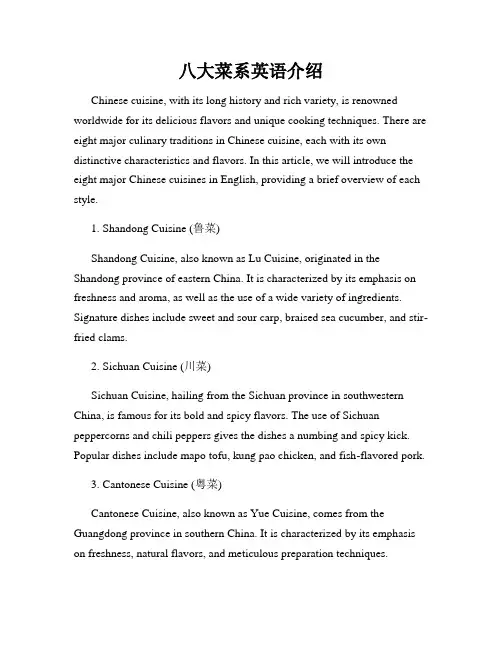
八大菜系英语介绍Chinese cuisine, with its long history and rich variety, is renowned worldwide for its delicious flavors and unique cooking techniques. There are eight major culinary traditions in Chinese cuisine, each with its own distinctive characteristics and flavors. In this article, we will introduce the eight major Chinese cuisines in English, providing a brief overview of each style.1. Shandong Cuisine (鲁菜)Shandong Cuisine, also known as Lu Cuisine, originated in the Shandong province of eastern China. It is characterized by its emphasis on freshness and aroma, as well as the use of a wide variety of ingredients. Signature dishes include sweet and sour carp, braised sea cucumber, and stir-fried clams.2. Sichuan Cuisine (川菜)Sichuan Cuisine, hailing from the Sichuan province in southwestern China, is famous for its bold and spicy flavors. The use of Sichuan peppercorns and chili peppers gives the dishes a numbing and spicy kick. Popular dishes include mapo tofu, kung pao chicken, and fish-flavored pork.3. Cantonese Cuisine (粤菜)Cantonese Cuisine, also known as Yue Cuisine, comes from the Guangdong province in southern China. It is characterized by its emphasis on freshness, natural flavors, and meticulous preparation techniques.Cantonese cuisine is known for its delicate flavors and use of fresh seafood. Signature dishes include dim sum, sweet and sour pork, and steamed fish.4. Hunan Cuisine (湘菜)Hunan Cuisine, from the Hunan province in central China, is renowned for its bold and spicy flavors. It is similar to Sichuan Cuisine but uses more chili peppers and garlic, resulting in a fiery and aromatic taste. Signature dishes include orange beef, spicy frog legs, and steamed fish head.5. Jiangsu Cuisine (苏菜)Jiangsu Cuisine, also known as Su Cuisine, originates from the Jiangsu province in eastern China. It is characterized by its emphasis on color, aroma, taste, and presentation. Jiangsu cuisine features delicate flavors and exquisite cooking techniques. Signature dishes include sweet and sour spare ribs, braised pork belly, and crystal shrimp dumplings.6. Zhejiang Cuisine (浙菜)Zhejiang Cuisine, from the Zhejiang province in eastern China, is known for its fresh and tender flavors. It emphasizes the use of fresh seafood, bamboo shoots, and other local ingredients. Zhejiang cuisine is light, refreshing, and often features delicate flavors. Signature dishes include Dongpo pork, West Lake vinegar fish, and beggar's chicken.7. Fujian Cuisine (闽菜)Fujian Cuisine, from the Fujian province in southeastern China, is known for its emphasis on umami flavors and seafood. It features a combination of sweet, sour, salty, and savory tastes. Fujian cuisine is knownfor its soups, seafood dishes, and delicate flavors. Signature dishes include Buddha Jumps Over the Wall, drunken chicken, and oyster omelette.8. Anhui Cuisine (徽菜)Anhui Cuisine, from the Anhui province in eastern China, is known for its emphasis on wild and natural ingredients. It features braising, stewing, and steaming techniques to highlight the natural flavors of the ingredients. Anhui cuisine is hearty, rustic, and nutritious. Signature dishes include Beggar's Chicken, Huangshan braised tofu, and fried mandarin fish.In conclusion, Chinese cuisine is incredibly diverse and offers a range of flavors and cooking styles to suit every palate. The eight major Chinese cuisines each have their own unique characteristics and history, showcasing the culinary traditions of China. Whether you prefer spicy Sichuan dishes, delicate Cantonese dim sum, or hearty Anhui cuisine, there is something for everyone to enjoy in Chinese cuisine.。
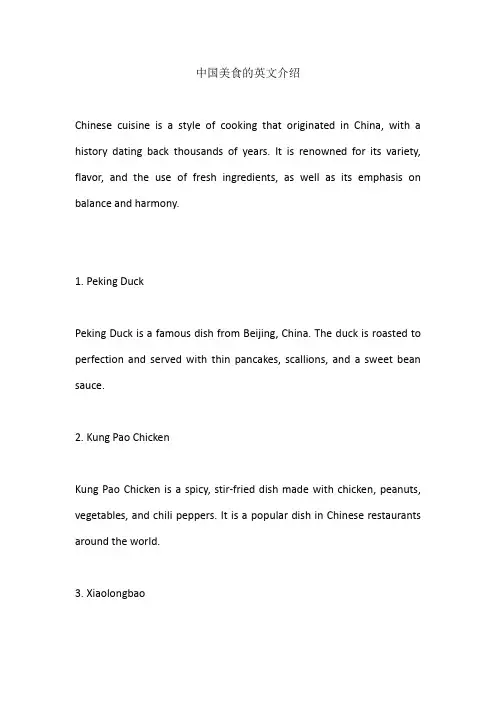
中国美食的英文介绍Chinese cuisine is a style of cooking that originated in China, with a history dating back thousands of years. It is renowned for its variety, flavor, and the use of fresh ingredients, as well as its emphasis on balance and harmony.1. Peking DuckPeking Duck is a famous dish from Beijing, China. The duck is roasted to perfection and served with thin pancakes, scallions, and a sweet bean sauce.2. Kung Pao ChickenKung Pao Chicken is a spicy, stir-fried dish made with chicken, peanuts, vegetables, and chili peppers. It is a popular dish in Chinese restaurants around the world.3. XiaolongbaoXiaolongbao are small, steamed dumplings filled with soup and meat. They are served in bamboo baskets and are a popular snack in China.4. MaotaiMaotai is a type of Chinese liquor made from fermented sorghum. It has a strong, distinct flavor and is often served at special occasions and banquets.5. Hot PotHot Pot is a Chinese cooking method where raw ingredients are cooked in a pot of simmering broth at the table. Diners can choose from a variety of meats, vegetables, and noodles to add to the pot.6. Dim SumDim Sum refers to a style of Chinese cuisine that consists of small, bite-sized dishes served in bamboo baskets or on small plates. It is often served as a snack or brunch and includes items such as steamed dumplings, buns, and rolls.7. ZongziZongzi are glutinous rice dumplings wrapped in bamboo leaves and filled with various ingredients such as meat, eggs, or beans. They are a traditional Chinese snack that is often eaten during the Dragon Boat Festival.8. DoufunaDoufuna, or tofu pudding, is a soft and silky tofu dish that is often served as a breakfast food in China. It can be sweet or savory and is often served with soy sauce, pickled vegetables, or other toppings.9. Peking Roast BeefPeking Roast Beef is a dish of thinly sliced beef that is roasted over an open flame and served with scallions, cucumbers, and a sweet bean sauce. It is a popular dish in northern China, especially in Beijing.10. Hot and Sour SoupHot and Sour Soup is a spicy and tangy soup made with a variety ofingredients such as chicken, pork, tofu, and vegetables. It is a popular dish in Chinese restaurants around the world and is often served as an appetizer or side dish.。

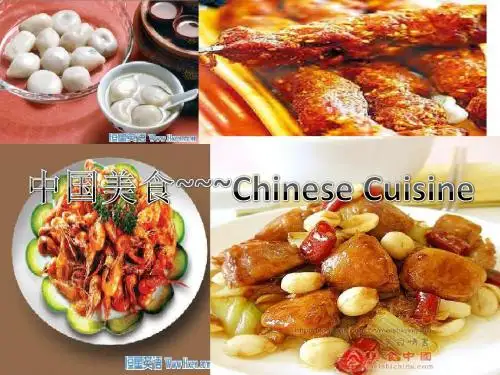
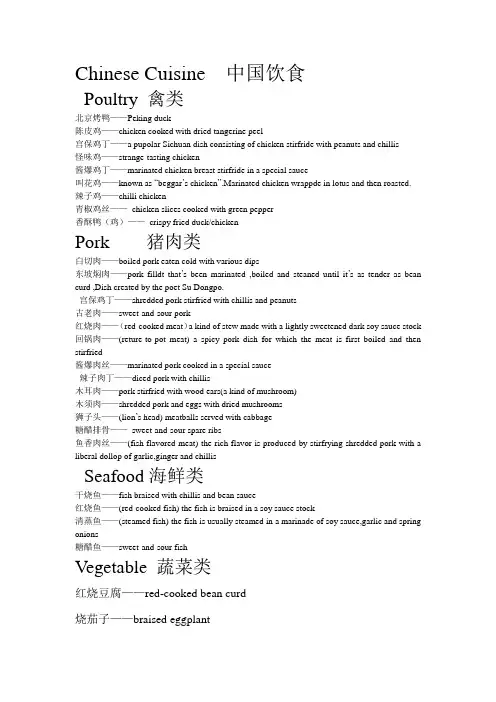
Chinese Cuisine 中国饮食Poultry 禽类北京烤鸭——Peking duck陈皮鸡——chicken cooked with dried tangerine peel宫保鸡丁——a pupolar Sichuan dish consisting of chicken stirfride with peanuts and chillis怪味鸡——strange-tasting chicken酱爆鸡丁——marinated chicken breast stirfride in a special sauce叫花鸡——known as “beggar’s chicken”.Marinated chicken wrappde in lotus and then roasted.辣子鸡——chilli chicken青椒鸡丝——chicken slices cooked with green pepper香酥鸭(鸡)——crispy fried duck/chickenPork 猪肉类白切肉——boiled pork eaten cold with various dips东坡焖肉——pork filldt that’s been marinated ,boiled and steaned until it’s as tender as bean curd ,Dish created by the poet Su Dongpo.宫保鸡丁——shredded pork stirfried with chillis and peanuts古老肉——sweet-and-sour pork红烧肉——(red-cooked meat)a kind of stew made with a lightly sweetened dark soy sauce stock 回锅肉——(reture-to-pot meat) a spicy pork dish for which the meat is first boiled and then stirfried酱爆肉丝——marinated pork cooked in a special sauce辣子肉丁——diced pork with chillis木耳肉——pork stirfried with wood ears(a kind of mushroom)木须肉——shredded pork and eggs with dried mushrooms狮子头——(lion’s head) meatballs served with cabbage糖醋排骨——sweet-and-sour spare ribs鱼香肉丝——(fish-flavored meat) the rich flavor is produced by stirfrying shredded pork with a liberal dollop of garlic,ginger and chillisSeafood海鲜类干烧鱼——fish braised with chillis and bean sauce红烧鱼——(red-cooked fish) the fish is braised in a soy sauce stock清蒸鱼——(steamed fish) the fish is usually steamed in a marinade of soy sauce,garlic and spring onions糖醋鱼——sweet-and-sour fishVegetable 蔬菜类红烧豆腐——red-cooked bean curd烧茄子——braised eggplantSoup 汤鸡蛋汤——egg-drop soup鸡汤——chicken soup西红柿鸡蛋汤——egg and tomato soupDessert 甜点杏仁酥——almond biscuit月饼——lotus-paste cake eaten at the mid-Autumnfestival ,Zhong Qiu Jie Food 食品Mutton 羊肉bacon 烤肉,熏肉Beef 牛肉chicken 鸡肉Dog meat 狗肉duck 鸭肉Frog 蛙肉ham 火腿Kebab 烤肉串lamb 小羊肉Liver 肝pork 猪肉Sausage 香肠turkey 火鸡肉Venison 鹿肉Aquatic Products 水产Abalone 鲍鱼bream 鳊鱼Carp 鲤鱼crap 螃蟹Eel 鳝鱼fish 鱼Hairtail 带鱼lobster 龙虾Perch 鲈鱼prawns 对虾Seafood 海鲜shark’s fin 鱼翅Shrimp 虾squid 鱿鱼Soft-shelled turtle 甲鱼yellow croaker 大黄鱼Vegetable 蔬菜Asparagus 笋bamboo shoots 竹笋Beans 豆beet 甜菜Broccoli 花椰菜carrot 胡萝卜Cauliflower 菜花celery 芹菜Chilli 辣椒Chinese cabbage 白菜Cucumber 黄瓜eggplant 茄子Garlic 大蒜Ginger 姜Green Chingese onion 大葱leek 韭菜Lettuce 莴笋mushroom 蘑菇Onion 洋葱pepper 青椒Potato 土豆pumpkin 南瓜Radish 萝卜rape 油菜Spinach 菠菜tomato 西红柿Turnip 芜菁/芜菁甘蓝wax/ White gourd 冬瓜Fruits 水果Apple 苹果apricot 杏Banana 香蕉cherries 樱桃Chinese dates 枣coconut 椰子Grapes 葡萄kiwi fruit 猕猴桃Lemon 柠檬loquat 枇杷Lychees 荔枝mango 芒果Muskmelon 哈密瓜orange 橘子Peach 桃子pear 梨Plum 李子strawberry 草莓Sweet melon 甜瓜tangerine 柑橘Watermelon 西瓜Dairy products 乳品Butter 黄油cheese 奶酪Cream 奶油ice cream 冰激淋Milk 奶yogurt 酸奶Condiments 调味品(Black )pepper 黑胡椒chilli 辣椒Chilli sauce 辣酱cinnamon 桂皮Cloves 丁香honey 蜂蜜Monosodium glutimate(MSG)味精salt 盐Sesame seed oil 芝麻油soy sauce 酱油Star aniseed 大料sugar 糖Tomato sauce 番茄酱vinegar 醋Other foods 其他食品Bean curd 豆腐biscuits 饼干Bread 面包buns(steamed)包子Cake 蛋糕congee(rice porridge) 稀饭/粥Dessert 甜品dumping 饺子Egg 鸡蛋horsd’oeuvre(cold)冷拼盘Noodles 面条rice noodles 米线/米粉Noodles in soup 汤面noodles(fried)炒面Pastry 糕点peanuts 花生Rice 大米/米饭fried rice 炒饭Suop 汤toast 烤面包Alcoholic drinks 酒类饮料Beer 啤酒brandy 白兰地Mao tai 茅台spirits 白酒V odka 伏特加white/red wine 白/红葡萄酒Rice wine 米酒whisky 威士忌Wine 葡萄酒Non-alcoholic drinks/soft drinks 非酒类饮料/软饮料Black coffee 黑咖啡coffee 咖啡Coke-cola 可口可乐fizzy drink 汽水Fruit juice 果汁green tea 绿茶Jasmine tea 茉莉花茶lemonade 柠檬汁Milk 牛奶mineral water 矿泉水Oolong tea 乌龙茶Pepsi 百事可乐Seven-up 七喜soda water 苏打水Soy milk 豆奶sprite 雪碧Tea 茶water 水Appendix IV tableware 餐具Bowl 碗chopsticks 筷子Cup 杯子fork 叉子Knife 刀子plate 盘子Soup spoon 汤匙spoon 勺子Toothpick 牙签V olleyball 排球Aces piker 主攻手setter 二传手Block 拦网 a back toss 背传A deep shot 长传 a dink 吊球Hook floating 勾手飘球overhead floating 上手飘球Serve miss 发球失误hold 持球Major world competitions 世界主要体育大赛Universiade 世界大学生运动会Winter Olympic games 冬季奥运会Summer Olympic games 夏季运动会The Asian games 亚运会Paralytic games 残奥会World cup(football)世界杯足球赛World table tennis championship 世界乒乓球锦标赛The international(Thomas cup)men’badminton team tournament 托马斯杯男子羽毛球团体锦标赛Uber cup wommen’s badminton team tournament 尤伯杯女子羽毛球团体锦标赛All Britain lawn tennis tournament 全英草地网球锦标赛Davis cup tennis tournament 戴维斯杯网球锦标赛NBA basketball championships NBA 篮球赛。
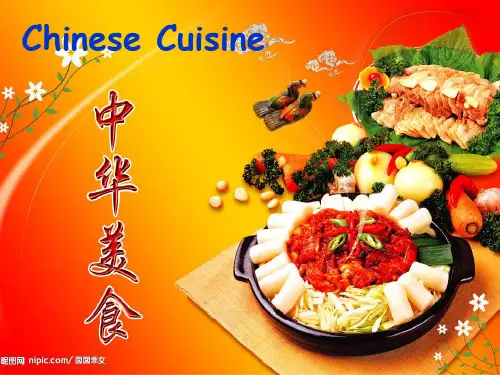
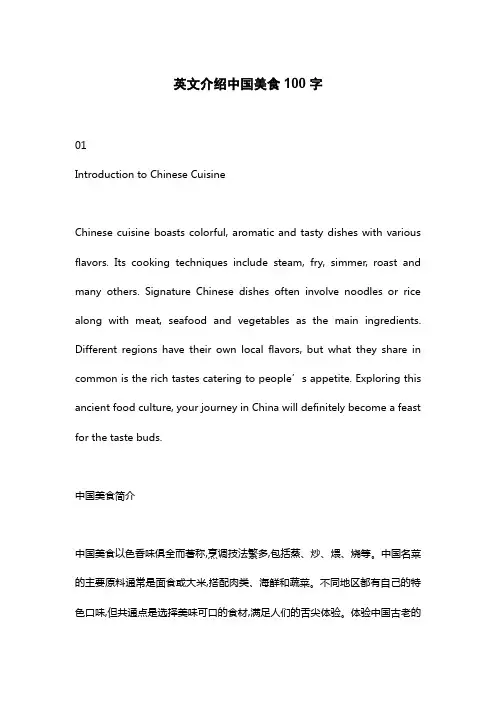
英文介绍中国美食100字01Introduction to Chinese CuisineChinese cuisine boasts colorful, aromatic and tasty dishes with various flavors. Its cooking techniques include steam, fry, simmer, roast and many others. Signature Chinese dishes often involve noodles or rice along with meat, seafood and vegetables as the main ingredients. Different regions have their own local flavors, but what they share in common is the rich tastes catering to people’s appetite. Exploring this ancient food culture, your journey in China will definitely become a feast for the taste buds.中国美食简介中国美食以色香味俱全而著称,烹调技法繁多,包括蒸、炒、煨、烧等。
中国名菜的主要原料通常是面食或大米,搭配肉类、海鲜和蔬菜。
不同地区都有自己的特色口味,但共通点是选择美味可口的食材,满足人们的舌尖体验。
体验中国古老的饮食文化,你的旅程定会成为一次味蕾的盛宴。
02Introduction to Chinese FoodFrom North to South, East to West, Chinese food varies greatly across its vast land, characterized by different cooking styles. But some constants bind them together - the harmony of color, aroma, taste and nutrition. The cuisine perfectly balances the contrasting textures of crispy and tender, taking into great consideration of health preservation. As an old saying goes, food is the paramount necessity of people. Through Chinese food, you can get a glimpse into its profound food philosophy, the wisdom of respecting nature's gifts and nourishing life.中国美食介绍从南到北,从东到西,中国美食因地域辽阔而千变万化,烹调方法各具特色。
中国菜ChineseCuisine厨房⼤师傅做菜的场景Cooks preparing dishes in a kitchen民以⾷为天。
中国⼈⾃古以来就重视饮⾷。
中国菜具有历史悠久、技艺精湛、品类丰富、流派众多、风格独特的特点。
Food is the first necessity of the people. Chinese people have made much of beverage and food since remote antiquity, and Chinese cuisine features along history, marvelous skills, rich variety, various styles and unique characteristics.世界名厨甄⽂达推介北京宫廷菜The Palace Cuisine is recommended by the well recongnized chef Martin Yan中国地域辽阔,各地物产、⽓候和⽣活习惯不同,⼈们的⼝味也各不相同,这样就形成了各具地⽅特⾊的中国菜系。
其中主要有⼋⼤菜系:鲁菜、川菜、粤菜、闽菜、苏菜、浙菜、湘菜、徽菜。
同时,也有四⼤菜系之说,通常指鲁菜、川菜、粤菜和淮扬菜。
China has a vast territory, and the produce, climate and living habits vary from place to place. As a result, people from different regions have distinctive tastes, thus forming many Chinese cuisine styles with unique indigenous flavors. In particular, the eight major cuisine styles are Shandong cuisine, Sichuan cuisine, Guangdong cuisine, Fujian cuisine, Jiangsu cuisine, Zhejiang cuisine, Hunan cuisine and Anhui cuisine. Meanwhile, there is also the parlance of four cuisine styles, which are usually Shandong cuisine, Sichuan cuisine, Guangdong cuisine and Huai-Yang cuisine.川菜⽕锅The hot pot of Sichuan cuisine中国菜不但花样多,⽽且讲究⾊、⾹、味、形俱佳。
chinesecuisine英文作文"英文,"Chinese cuisine is one of the most diverse anddelicious cuisines in the world. From the spicy flavors of Sichuan cuisine to the delicate dim sum of Cantonese cuisine, there is something for everyone to enjoy. One ofmy favorite Chinese dishes is Kung Pao Chicken, which is a spicy and savory stir-fry dish with peanuts and vegetables. The combination of flavors and textures in this dish is simply amazing.Another popular Chinese dish that I love is Peking duck. The crispy skin and succulent meat of the duck, wrapped ina thin pancake with hoisin sauce and scallions, is a true culinary delight. It's a dish that I always look forward to enjoying whenever I visit a Chinese restaurant.中文:中国菜是世界上最多样化和美味的菜系之一。
从四川菜的辛辣风味到粤菜的精致点心,每个人都能找到自己喜欢的菜肴。
我最喜欢的中国菜之一是宫保鸡丁,这是一道辛辣可口的炒菜,配有花生和蔬菜。